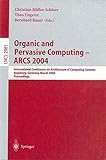Organic and Pervasive Computing -- ARCS 2004 [electronic resource] : International Conference on Architecture of Computing Systems, Augsburg, Germany, March 23-26, 2004, Proceedings /
Material type: TextSeries: Lecture Notes in Computer Science ; 2981Publisher: Berlin, Heidelberg : Springer Berlin Heidelberg : Imprint: Springer, 2004Edition: 1st ed. 2004Description: XI, 329 p. online resourceContent type:
TextSeries: Lecture Notes in Computer Science ; 2981Publisher: Berlin, Heidelberg : Springer Berlin Heidelberg : Imprint: Springer, 2004Edition: 1st ed. 2004Description: XI, 329 p. online resourceContent type: - text
- computer
- online resource
- 9783540247142
- Computer systems
- Computer networks
- Software engineering
- Operating systems (Computers)
- Information storage and retrieval systems
- Application software
- Computer System Implementation
- Computer Communication Networks
- Software Engineering
- Operating Systems
- Information Storage and Retrieval
- Computer and Information Systems Applications
- 004.2 23
- QA76.9.S88
Invited Program -- Keynote Autonomic Computing Initiative -- Keynote Multithreading for Low-Cost, Low-Power Applications -- I Organic Computing -- The SDVM: A Self Distributing Virtual Machine for Computer Clusters -- Heterogenous Data Fusion via a Probabilistic Latent-Variable Model -- Self-Stabilizing Microprocessor -- Enforcement of Architectural Safety Guards to Deter Malicious Code Attacks through Buffer Overflow Vulnerabilities -- II Peer-to-Peer -- Latent Semantic Indexing in Peer-to-Peer Networks -- A Taxonomy for Resource Discovery -- Oasis: An Architecture for Simplified Data Management and Disconnected Operation -- Towards a General Approach to Mobile Profile Based Distributed Grouping -- III Reconfigurable Hardware -- A Dynamic Scheduling and Placement Algorithm for Reconfigurable Hardware -- Definition of a Configurable Architecture for Implementation of Global Cellular Automaton -- RECAST: An Evaluation Framework for Coarse-Grain Reconfigurable Architectures -- IV Hardware -- Component-Based Hardware-Software Co-design -- Cryptonite – A Programmable Crypto Processor Architecture for High-Bandwidth Applications -- STAFF: State Transition Applied Fast Flash Translation Layer -- Simultaneously Exploiting Dynamic Voltage Scaling, Execution Time Variations, and Multiple Methods in Energy-Aware Hard Real-Time Scheduling -- V Wireless Architectures and Networking -- Application Characterization for Wireless Network Power Management -- Frame of Interest Approach on Quality of Prediction for Agent-Based Network Monitoring -- Bluetooth Scatternet Formation – State of the Art and a New Approach -- A Note on Certificate Path Verification in Next Generation Mobile Communications -- VI Applications -- The Value of Handhelds in Smart Environments -- Extending the MVC Design Pattern towards aTask-Oriented Development Approach for Pervasive Computing Applications -- Adaptive Workload Balancing for Storage Management Applications in Multi Node Environments.
Where is system architecture heading? The special interest group on Computer and Systems Architecture (Fachausschuss Rechner- und Systemarchitektur) of the German computer and information technology associations GI and ITG a- ed this question and discussed it during two Future Workshops in 2002. The result in a nutshell: Everything will change but everything else will remain. Future systems technologies will build on a mature basis of silicon and IC technology,onwell-understoodprogramminglanguagesandsoftwareengineering techniques, and on well-established operating systems and middleware concepts. Newer and still exotic but exciting technologies like quantum computing and DNA processing are to be watched closely but they will not be mainstream in the next decade. Although there will be considerable progress in these basic technologies, is there any major trend which uni?es these diverse developments? There is a common denominator – according to the result of the two - ture Workshops – which marks a new quality. The challenge for future systems technologies lies in the mastering of complexity. Rigid and in?exible systems, built under a strict top-down regime, have reached the limits of manageable complexity, as has become obvious by the recent failure of several large-scale projects. Nature is the most complex system we know, and she has solved the problem somehow. We just haven’t understood exactly how nature does it. But it is clear that systems designed by nature, like an anthill or a beehive or a swarm of birds or a city, are di?erent from today’s technical systems that have beendesignedbyengineersandcomputerscientists.


There are no comments on this title.